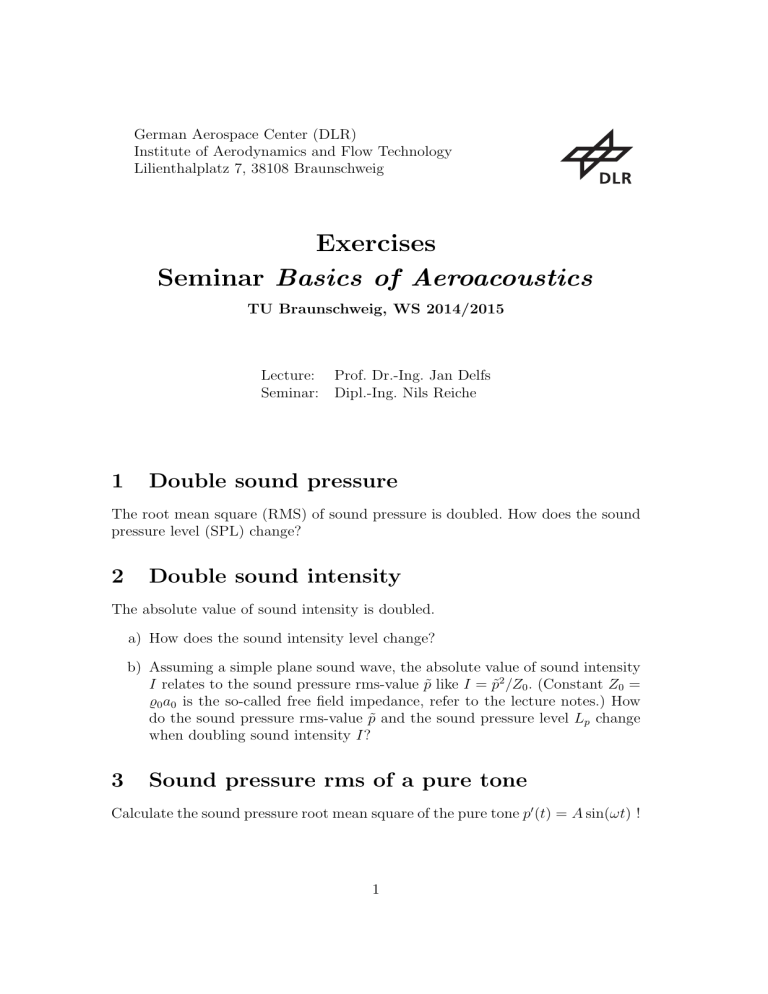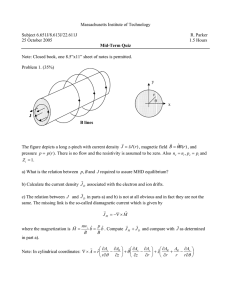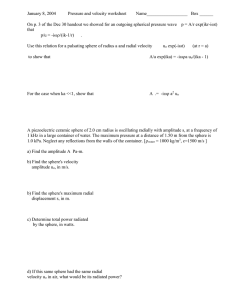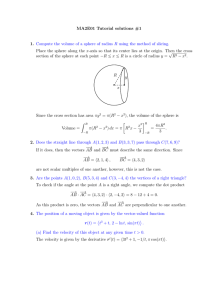Exercises Seminar Basics of Aeroacoustics

German Aerospace Center (DLR)
Institute of Aerodynamics and Flow Technology
Lilienthalplatz 7, 38108 Braunschweig
Exercises
Seminar Basics of Aeroacoustics
TU Braunschweig, WS 2014/2015
Lecture: Prof. Dr.-Ing. Jan Delfs
Seminar: Dipl.-Ing. Nils Reiche
1 Double sound pressure
The root mean square (RMS) of sound pressure is doubled. How does the sound pressure level (SPL) change?
2 Double sound intensity
The absolute value of sound intensity is doubled.
a) How does the sound intensity level change?
b) Assuming a simple plane sound wave, the absolute value of sound intensity
I relates to the sound pressure rms-value ˜ like I = ˜
2
/Z
0
. (Constant Z
0
=
%
0 a
0 is the so-called free field impedance, refer to the lecture notes.) How do the sound pressure rms-value ˜ and the sound pressure level L p when doubling sound intensity I ?
change
3 Sound pressure rms of a pure tone
Calculate the sound pressure root mean square of the pure tone p
0
( t ) = A sin( ωt ) !
1
4 Composed pressure signal
Following pressure signal is given: p ( t ) = C + A
1 sin( ω
1 t ) + A
2 sin( ω
2 t + ϕ ) .
a) What is this signal’s sound pressure RMS?
b) What is this signal’s sound pressure level?
c) Assume that following conditions hold: ω
1
Calculate the difference ∆ L p
= ω
2
= ω , A
1
= A
2
= A to the sound pressure level of a pure tone
.
with the same amplitude A (refer to exercise 3)! Sketch ∆ L p as a function of phase angle ϕ !
5 Loudness I
What is the perceived difference in loudness between a pure tone of frequency f
1
= 3000 Hz and a pure tone of frequency f
2 the same sound pressure level of L p 1
= L p 2
= 300 Hz, when both tones have
= 100 dB?
6 Loudness II
What is the sound pressure level L p 1 of a pure tone of frequency f
1 that is perceived as loud as a pure tone at f
2
= 100 Hz
= 1000 Hz having a sound pressure level of L p 2
= 70 dB?
7 Average Sound Pressure Level (SPL)
Compute the average of the three sound pressure levels L p 1 and L p 3
= 90 dB
= 80 dB, L p 2
= 85 dB, a) approximately as arithmetic mean!
b) exactly by averaging the sound pressure mean square values (assuming uncorrelated signals)!
8 OverAll Sound Pressure Level (OASPL)
Following octave band levels were measured: f
L i c i in Hz: p 1 / 1 in dB:
125
68.0
250
70.5
500
72.5
1000
77.0
2000
75.5
4000
71.5
8000
68.5
What is the overall sound pressure level ?
.
2
9 White noise
A signal has a constant power spectral density ˆ ( f ) = P
0
(ideal white noise).
a) Compute this signal’s third octave and octave band levels L i pm
!
b) How do these band levels change from band i to band i + 1?
c) Sketch the octave band spectrum L i p 1 / 1
!
d) Why is this signal called “white noise”?
e) Does ideal white noise exist in reality? What is its mean square value?
10 Pink noise
Ideal pink noise is a stochastic signal with constant m-band levels L i pm
.
a) Compute (for m = 1) the ratio
ˆ
( f )! Hints:
ˆ
( f u i
)
ˆ
( f i l
) and sketch the power spectral density
– L i pm
= const.
⇒ ˜ 2 i
= const.
⇒ d ˜ df
2 i c i
– ˜
2 i
= R b a
= 0,
ˆ
( f ) df , where a := f i l
= 2
− m/ 2 f i c and b := f i u
= 2 m/ 2 f i c
.
b) Why is this signal called “pink noise”?
c) Can ideal pink noise exist in reality? What is its mean square value?
11 Governing equations in primitive form
The governing equations of fluid dynamics 1 are given by the continuity equation
(31), the momentum equations (32) and the energy equation (33). Equations (31)-
(33) are in conservation form. However, the primitive form is more appropriate as a starting point for acoustics.
a) Derive the continuity equation (35) in primitive form!
b) Derive the momentum equations (36) in primitive form (lecture notes may be helpful)!
1 same numbering as in lecture, hopefully
3
12 Speed of sound in air
Under standard conditions air is characterized by: p
0
%
0
=
=
1
1 .
.
01325
292 kg
·
/
T
0
= 273.15 K.
10 m
5
3
Pa
What is the speed of sound a) for these standard conditions?
b) when the temperature increases to 25
◦
C or to 350
◦
C?
c) for the same temperature, but twice the ambient pressure?
13 Linear momentum perturbation equations I
Derive the momentum perturbation equations (55) from the momentum equations
(48) by linearization around a time independent base flow! Use the standard perturbation approach from the lecture notes:
1. Decompose the flow variables using parameter ε (0 ≤ ε 1), e.g.
p = p
0
+ εp
0
;
2. Insert the decomposed variables into (48). This gives a function obeys
~
( ε ) = 0;
~
( ε ) that
3. Develop
~
( ε ) into a Taylor series around
~
( ε = 0);
4. Linearize by assuming ε 1 (small perturbations) in the Taylor series.
14 Linear momentum pert. equations II
Derive the momentum perturbation equations (55) from the momentum equations (48) by linearization around a time independent base flow! Do not use the standard perturbation approach as in exercise 13, but use the following technique instead:
1. Decompose the flow variables without using a parameter ε , i.e., b = b
0 where b ∈ { %, v , p, f } ;
+ b
0
,
2. Linearize by assuming | b
0 | | b
0
| (neglect “prime products”).
4
15 Plane sound wave, parameters
The following equation describes a sound wave travelling through air: p
0
( x, t ) = 6 .
25 exp[ i (471 .
2 t − 1 .
37 x )] .
Following holds: p
0 in Pa, t in s, x in m, %
0
= 1 .
292 kg / m 3 . Calculate a) the frequency f , b) the wave length λ , c) the speed of sound a
0
, d) the ambient temperature T
0
, e) the RMS value ˜ of sound pressure, f) the RMS value ˜ of sound velocity, g) the sound intensity I , h) the sound pressure level L p
, i) the physical solution p
0
( x, t ) phys
!
16 Helmholtz equation
Derive the Helmholtz equation (69) from the wave equation (61) for the sound pressure perturbations! Hints: Replace p
0
( x , t ) and Q p
( x , t ) in equation (61) according to equation (23) for the inverse Fourier transform, i.e.: p
0
( x , t ) =
Q p
( x , t ) =
1
2 π
1
2 π
Z
+ ∞
−∞
Z
+ ∞
Q p
( x , ω ) exp( iωt ) dω
−∞
ˆ ( x , ω ) exp( iωt ) dω
5
17 Pressure form of Lighthill’s analogy
Sir Michael James Lighthill published the following famous inhomogeneous wave equation (251) for density perturbations in 1952:
∂ 2 %
0
∂t 2
− a
2
∞
∆ %
0
= ∇ · ∇ · ( % vv + ( p
0
− a
2
∞
%
0
) I − τ ) .
He derived it through simple rearrangement of the Navier-Stokes equations. Derive the inhomogeneous wave equation (253) for pressure perturbations, being
1 a 2
∞
∂ 2 p
0
∂t 2
− ∆ p
0
= ∇ · ∇ · ( % vv − τ ) +
1 a 2
∞
∂ 2
∂t 2
( p
0
− a
2
∞
%
0
)!
Hint: As the only difference to the derivation of equation (251), another term than a
2
∞
∆ % has to be subtracted.
18 Lighthill’s analogy - jet noise
The noise of an engine’s jet is supposed to be reduced by enlarging its diameter
D . The original jet speed is U s
, and its thrust is supposed to remain constant.
How does the sound intensity level L
I decrease, when the jet’s diameter increases from D
1 to D
2
= 1 .
5 D
1
? Hints:
• Use the famous estimate for the sound intensity of a jet, which was derived from Lighthill’s acoustic analogy: I ∝
|
1 x
| 2
%
∞ a
5
0
D 2 U 8 s
(270).
• The jet’s thrust is: F = %U 2 s
A = %U 2 s
π
4
D 2 .
19 Wavy wall
An infinite, two-dimensional, wavy wall moves steadily into positive x -direction at the speed v > 0, see the figure below.
y v y w
(x,t)
H x
λ
w
6
In complex notation, the wall surface is given by y w
( x, t ) = H exp( i ( α w vt − α w x )) ,
α w
= 2 π/λ w
> 0 being its wavenumber. The height H is assumed to be small.
The ambient medium is assumed to be at rest, v
0
= 0, and to have some constant mean density %
0
.
a) Calculate the resulting velocity potential for the two cases M = v/a
0
< 1 and M > 1, where a
0 is the speed of sound in the surrounding medium, and M denotes the wall-related Mach number! Hints:
1. Start with the following solution approach:
Φ = A exp ( iωt − iαx − iβy ) .
2. Set the y -component of the wall’s vibration velocity ( v
0 yw to that of the acoustic particle velocity ( v
0 y
). Since H
) locally equal is small, v
0 yw
= v
0 y
( y = 0) approximately holds. Particular solutions for ω and α follow.
3. Calculate particular solutions for β and A by inserting the above solution approach for Φ into the respective two-dimensional, homogeneous wave equation, which gives the dispersion relation (75).
Afterwards, insert the solutions for ω and α from step 2 into the dispersion relation. Two possible solutions for β follow. Choose the physically meaningful one for both of the cases M < 1 and M > 1.
You should end up with the following results:
Φ = vH i
√
1 − M 2 exp ( − α w y
√
1 − M 2 ) exp ( iα w vt − iα w x ); M < 1 ,
Φ = − vH
√
M 2 − 1 exp ( − iα w y
√
M 2 − 1) exp ( iα w vt − iα w x ); M > b) Calculate the physical part p
0 phys case M > 1 using the respective result from subtask a) ! Does p
0 phys sound waves 2 of the pressure perturbation field for the
? Sketch the pressure field!
describe
1 .
c) Now also calculate the physical part p
0 phys of the pressure perturbation field for the case M < 1 using the respective result from subtask a) ! Does p
0 phys describe sound waves? Sketch the pressure field!
2 Definition of sound wave: wavelike propagation of small pressure and density perturbations at the speed of sound a
0
(ambient medium at rest).
7
20 Breathing sphere (monopole model)
A sphere oscillates radially about its average radius R with a small amplitude
A
R
R at a circular frequency of Ω, see the figure below. In complex notation, the time-dependent radius of the sphere’s surface is thus given by δ ( t ) = R +
A
R exp( i Ω t ). The ambient medium is assumed to be at rest, v
0
= 0, and to have some constant mean density %
0
.
a) Calculate the radiated sound pressure field in complex representation!
1. Begin by calculating the velocity potential using following solution approach:
A
Φ
Φ = exp ( iωt − ikr ) , r ≥ δ ( t ) .
r
2. Calculate the particular solution of Φ, i.e., calculate A
Φ this end, calculate the generic radial component v
0 r and ω ! To of the acoustic particle velocity from the above solution approach for Φ as well as the sphere’s radial vibration velocity v
0
K from δ ( t ). These two velocities are the same on the sphere’s surface, i.e., making use of A
R v
0
K
( r = δ ( t )) = v r
0
( r = R ) approximately holds.
R ,
3. Finally calculate the sound pressure field p
0 tion of the velocity potential Φ!
from the particular solu-
You should end up with: p
0
( r, t ) = r
%
0
Ω
2
A
R
R
( − ik − 1
R
) exp ( i Ω t − ik ( r − R )) , r ≥ δ ( t ) .
b) A breathing sphere can model sound generation through pulsation or pulsating outflow. Which sound sources may thus concretely be replicated? Give examples!
8
21 Oscillating sphere (dipole model)
A rigid, massless sphere of radius R oscillates harmonically in z -direction with a small amplitude A z
R at a circular frequency of Ω, see the figure below.
In complex notation, the sphere’s time-dependent displacement in z -direction is: δ zK
( t ) = A z exp( i Ω t ). Again, the ambient medium is assumed to be at rest, v
0
= 0, and to have some constant mean density %
0
. Next to (fixed) Cartesian coordinates ( x, y, z ), (fixed) spherical coordinates ( r, θ, ϕ ), 0 ≤ θ ≤ π , 0 ≤ ϕ ≤
2 π , are employed to describe the problem.
a) The z -derivative of the velocity potential’s solution approach Φ
∗ from the breathing sphere (see exercise 20) is used to calculate the oscillating sphere’s velocity potential Φ. The solution approach for the breathing sphere was:
Φ
∗
=
A
Φ exp ( iωt − ikr ) , r r ≥ R.
Derive the the solution approach Φ for the velocity potential of the oscillating sphere (in spherical coordinates)!
b) Reasoning similar to exercises 19 and 20 finally leads to the following particular solution of the oscillating sphere’s velocity potential:
Φ = − r ( i Ω A z
( ik +
2
R 3
− k
2
R
+
1 r
)
2 ik
R 2
) exp ( i Ω t − ik ( r − R )) cos θ, r ≥ R.
What is the acoustic particle velocity field v
0 generated by the oscillating sphere (spherical coordinates)? How does it simplify for large distance r ?
c) An oscillating sphere can model sound generation through an external disturbance force. Which sound sources may thus concretely be replicated?
Give examples!
9
22 Multipoles, directivities
a) From equation (144), calculate and sketch the normalized directivities D ( θ, ϕ ) =
˜ ( θ,ϕ ) of a monopole and of a dipole! Hints:
˜ ( θ,ϕ ) max
– substitute some general, undetermined, monopole moment m
000
( τ
0
) and dipole moment m
001
( τ
0
) into eq. (144), and assume the reference point to be at ξ
0
= 0 .
– coordinates are chosen like in exercise 21, and x = x
1
, y = x
2
, z = x
3 holds.
b) Compare the normalized directivities from subtask a) to those resulting from the breathing and oscillating sphere from exercises 20 and
21, respectively!
23 Dirac function
A function f n
( x ) is given by: f n
( x ) =
0
2 n x +
1
1
2
− 1 x < − 1 n
≤ x ≤ n x >
1 n
.
1 n f n
(x)
1 n = 1 , 2 , . . .
x
−1/n 0 1/n
This function allows to describe the unit step function H ( x ) as the limit of the function series { f n
( x ) } for n → ∞ , i.e., lim n →∞ f n
( x ) = H ( x ).
a) Show that the function g n
( x ), being the x -derivative of f n
( x ), has the property lim n →∞ g n
( x ) = δ ( x ) !
b) Show the validity of the sifting property (108) for the Delta function δ ( x ) by way of function g n
( x ) from subtask a) !
Hints:
• According to the monotone convergence theorem, integration and calculation of the limit can be interchanged here: R b a lim n →∞ g n
( x ) dx = lim n →∞
R b a g n
( x ) dx.
• mean value theorem for integration: if s ( x ) is a continuous function on the interval [ a, b ], then there exists at least one value ξ ∈ [ a, b ], such that
R b a s ( x ) dx = s ( ξ )( b − a ) .
10
24 Vector notation vs. index notation
Differential operators and arithmetic operations on matrices and vectors have usually been represented in vector notation so far. However, the so-called index notation is often encountered in aeroacoustic literature, too.
In that case, indices identify a certain entry of a matrix or vector. For example,
T ij denotes the entry in row i and column j of matrix T , i.e., in the case of two indices, the first identifies the row, and the second the column, where the respective entry is to be found in a matrix. Moreover, Einstein’s summation convention applies for repeated subscripts. For example, assuming i ∈ { 1 , 2 } , a i b i
= a
1 b
1
+ a
2 b
2 holds.
a) Show the validity of
∂ 2 T ij
∂x i
∂x j
= ∇ · ∇ · T .
Assume two-dimensional Cartesian coordinates, i.e., i, j ∈ { 1 , 2 } , and
∇ =
∂
∂x
1
∂
∂x
2
.
b) Let T denote Lighthill’s stress tensor:
T = ( % vv + ( p
0
− a
2
∞
%
0
) I − τ ) .
What does entry T ij look like?
25 Sound power of oscillating sphere
Calculate the real mechanical power P mech
, which is required to make the massless sphere from exercise 21 oscillate, and compare it to the sound power P ac in the far-field. Which results are obtained for the special case of an incompressible medium? Use the particular solution of the velocity potential Φ from exercise 21.
11



